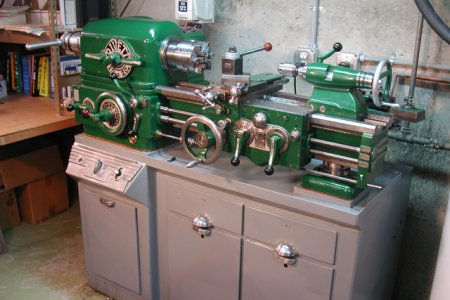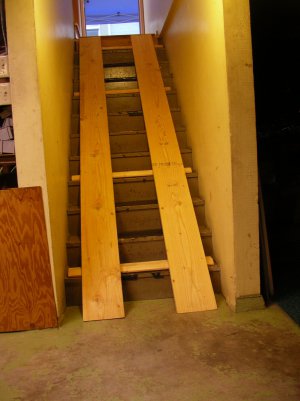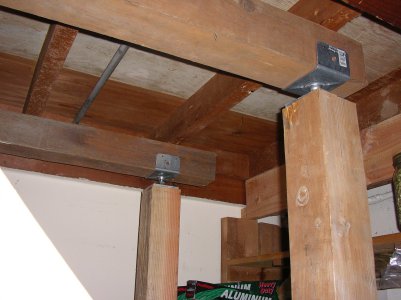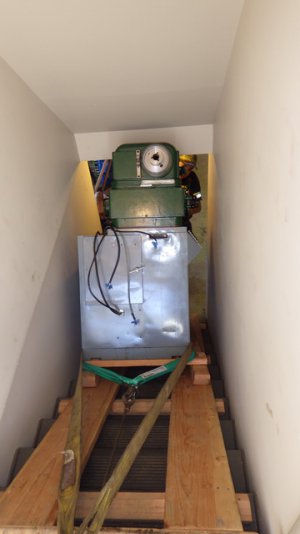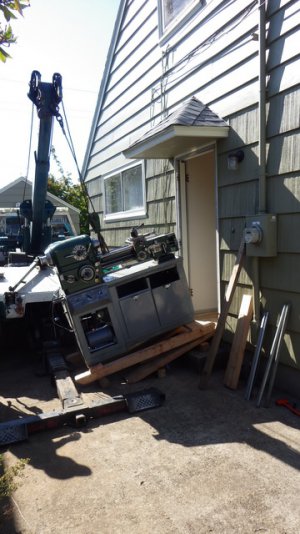Shouldn’t be that big of a deal really. Even if you remove the headstock. With a new or used lathe I find it is be to go through a setup procedure which includes checking or aligning the headstock, leveling the lathe and aligning the tail stock. So in reality you would just need to go through the usual steps of setting the machine up. I’m sure you can handle it if you have spent time around older heavier lathes. I’m kind of facing a challenge tomorrow of moving and setting up a Bridgeport mill. No stairs involved however it’s not gonna fit under my garage door so the machine has to come apart still the same.Did you take the headstock off? I just worry about getting everything back together properly and precisely the way they're supposed to be
-
Welcome back Guest! Did you know you can mentor other members here at H-M? If not, please check out our Relaunch of Hobby Machinist Mentoring Program!
You are using an out of date browser. It may not display this or other websites correctly.
You should upgrade or use an alternative browser.
You should upgrade or use an alternative browser.
Advice For New Basement Shop Lathe
- Thread starter Jud96
- Start date
- Joined
- Dec 18, 2022
- Messages
- 2,859
I would think either of those machines would be good for your purpose. I think the PM-1130V might also be a good machine to consider, the inch difference in swing would be made up for by the 2" of extra bed room and you still get a 1.5" spindle bore...I do barrel work through the headstock with an inboard and outboard spider. Thank you though! I’m considering a larger machine, but disassembling it then putting it back together is a little daunting to me
- Joined
- Dec 10, 2023
- Messages
- 134
1500 lb, pre-WWII Rivet 1020 slid down a flight of stairs into my basement to get it in. Substantial bracing and support put under the stairs to support the weight. 4x4 supports under the landing at the top of the stairs were preloaded so there would be no/nil sag under the weight. Stair jacks were also support (not shown), Same setup to drag it back up when getting it out, but hired a tow truck with a dual winch boom to do the pulling. Used the same stair bracing/support system. Tailstock, handles and drawers were all that were removed to reduce weight and provide clearance. What limited the extraction was the overall height, due to the skids.
Attachments
Last edited:
This is awesome!1500 lb, pre-WWII Rivet 1020 slid down a flight of stairs into my basement to get it in. Substantial bracing and support put under the stairs to support the weight. 4x4 supports under the landing at the top of the stairs were preloaded so there would be no/nil sag under the weight. Stair jacks were also support (not show), Same setup to drag it back up when getting it out, but hired a tow truck with a dual winch boom to do the pulling. Used the same stair bracing/support system. Tailstock, handles and drawers were all that were removed to reduce weight and provide clearance. What limited the extraction was the overall height, due to the skids.
- Joined
- Apr 29, 2019
- Messages
- 2,298
WAY back when I bought my Jet GH1340 it came down the interior basement steps in one piece as delivered from the factory. It is actually the lightest weight machine in my shop at only 1200 lbs. It came with the carriage and tail stock pushed all the way to the right as far as they would go, for balance, and had a lifting eye, factory installed to the bed, at exactly the center of gravity. I used a home made cart with 4 swivel casters that I bolted to the bottom of the lathe using the mounting holes of the lathe.
I have to come through the back door right turn down a hallway and then a left turn down the steps. The only lading for the steps is the hallway.
I was able to run a 12,000 lb rated cable from the machine thru the house and out a window and then to the trailer hitch on my 4x4 truck, preset into 4 Lo. I had a snatch block on my shop crane to hold the cable off of the window sill. Used the truck to control the decent. Was a very nice boring move. At one point the machine got turned a bit and the truck had no issue pulling it back up for a second try. This is the same process that I used to move the 1800 lb surface grinder down and the 3400 lb mill down there. I am confident that if I ever decide to move the truck will have no issue getting everything back up the steps.
I did reinforce the steps by laying 2 pieces of 2x12 laid flat and covered with 3/4 ply there were blocks on every step to the 2x12s the ramp was NOT flat onto the steps, the angle at the top would have been to steep and the cart would have hi-centered going over the edge. While the ramp had to line up with the floor at the top it was about 2 feet away from the bottom step. There was also 3/4 ply on all floor surfaces the the machines would cross.
I have since had to replace the stairs (nothing to due with the weights that have traversed them). The new stairs have that angle for the ramp built in and even though the stairs are only 36 wide, their are 4 stringers that were cut out of four 14" lam beams instead of the normal two 2x12s There are then support posts going to concrete foundation under every 3rd step. These new steps will handle anything I might ever want to move across them.
It seems daunting at first blush. but if you have a plan (with contingencies for what might possibly go amiss) and work the plan it makes for a nice boring move, the very best kind.
This was all long before digital cameras so there are no pics of the process.
I have to come through the back door right turn down a hallway and then a left turn down the steps. The only lading for the steps is the hallway.
I was able to run a 12,000 lb rated cable from the machine thru the house and out a window and then to the trailer hitch on my 4x4 truck, preset into 4 Lo. I had a snatch block on my shop crane to hold the cable off of the window sill. Used the truck to control the decent. Was a very nice boring move. At one point the machine got turned a bit and the truck had no issue pulling it back up for a second try. This is the same process that I used to move the 1800 lb surface grinder down and the 3400 lb mill down there. I am confident that if I ever decide to move the truck will have no issue getting everything back up the steps.
I did reinforce the steps by laying 2 pieces of 2x12 laid flat and covered with 3/4 ply there were blocks on every step to the 2x12s the ramp was NOT flat onto the steps, the angle at the top would have been to steep and the cart would have hi-centered going over the edge. While the ramp had to line up with the floor at the top it was about 2 feet away from the bottom step. There was also 3/4 ply on all floor surfaces the the machines would cross.
I have since had to replace the stairs (nothing to due with the weights that have traversed them). The new stairs have that angle for the ramp built in and even though the stairs are only 36 wide, their are 4 stringers that were cut out of four 14" lam beams instead of the normal two 2x12s There are then support posts going to concrete foundation under every 3rd step. These new steps will handle anything I might ever want to move across them.
It seems daunting at first blush. but if you have a plan (with contingencies for what might possibly go amiss) and work the plan it makes for a nice boring move, the very best kind.
This was all long before digital cameras so there are no pics of the process.
That’s inspiring! I was worried about moving my little 11” Rockwell into the basement. I’m not a carpenter, but my stairs just have a 2x12 board on either side with notches cut into the board that the steps slide into. I also added pieces of 2x4 under each side of the step and attached them to the 2x12 so that would add support to the steps. Again, I’m not a carpenter, but my steps didn’t cave in on me when we moved the Rockwell. They surprisingly didn’t move much at all. We used a furniture dolly and attached a tow rope to a tractor. We lowered the dolly down one step at a time and it was easy. Then moved everything in place with an engine hoist in the basement.WAY back when I bought my Jet GH1340 it came down the interior basement steps in one piece as delivered from the factory. It is actually the lightest weight machine in my shop at only 1200 lbs. It came with the carriage and tail stock pushed all the way to the right as far as they would go, for balance, and had a lifting eye, factory installed to the bed, at exactly the center of gravity. I used a home made cart with 4 swivel casters that I bolted to the bottom of the lathe using the mounting holes of the lathe.
I have to come through the back door right turn down a hallway and then a left turn down the steps. The only lading for the steps is the hallway.
I was able to run a 12,000 lb rated cable from the machine thru the house and out a window and then to the trailer hitch on my 4x4 truck, preset into 4 Lo. I had a snatch block on my shop crane to hold the cable off of the window sill. Used the truck to control the decent. Was a very nice boring move. At one point the machine got turned a bit and the truck had no issue pulling it back up for a second try. This is the same process that I used to move the 1800 lb surface grinder down and the 3400 lb mill down there. I am confident that if I ever decide to move the truck will have no issue getting everything back up the steps.
I did reinforce the steps by laying 2 pieces of 2x12 laid flat and covered with 3/4 ply there were blocks on every step to the 2x12s the ramp was NOT flat onto the steps, the angle at the top would have been to steep and the cart would have hi-centered going over the edge. While the ramp had to line up with the floor at the top it was about 2 feet away from the bottom step. There was also 3/4 ply on all floor surfaces the the machines would cross.
I have since had to replace the stairs (nothing to due with the weights that have traversed them). The new stairs have that angle for the ramp built in and even though the stairs are only 36 wide, their are 4 stringers that were cut out of four 14" lam beams instead of the normal two 2x12s There are then support posts going to concrete foundation under every 3rd step. These new steps will handle anything I might ever want to move across them.
It seems daunting at first blush. but if you have a plan (with contingencies for what might possibly go amiss) and work the plan it makes for a nice boring move, the very best kind.
This was all long before digital cameras so there are no pics of the process.
When I had the heating boiler replaced in my old house, the contractor put a 4x4 vertical center under each step. Four guys carried the old one out and the new one in and stairs didn’t budge. I liked not having any flex in the stairs, so I left after they were done.That’s inspiring! I was worried about moving my little 11” Rockwell into the basement. I’m not a carpenter, but my stairs just have a 2x12 board on either side with notches cut into the board that the steps slide into. I also added pieces of 2x4 under each side of the step and attached them to the 2x12 so that would add support to the steps. Again, I’m not a carpenter, but my steps didn’t cave in on me when we moved the Rockwell. They surprisingly didn’t move much at all. We used a furniture dolly and attached a tow rope to a tractor. We lowered the dolly down one step at a time and it was easy. Then moved everything in place with an engine hoist in the basement.
Was the 4x4 attached to each step, or just wedged under there? Any idea on the weight of the boiler?When I had the heating boiler replaced in my old house, the contractor put a 4x4 vertical center under each step. Four guys carried the old one out and the new one in and stairs didn’t budge. I liked not having any flex in the stairs, so I left after they were done.
Wedged underneath. I don’t recall the model boiler, but I recall them saying it was in the 500 pound range. Two guys on one side and two guys on the other, so each step was probably seeing 5-600lbs.Was the 4x4 attached to each step, or just wedged under there? Any idea on the weight of the boiler?
- Joined
- Apr 29, 2019
- Messages
- 2,298
What you have is very normal basement stair construction. It would take some time but you could cut and add another center stringer to the stairs or as was done above add a 4x4 post to every step or even every other step. but all of those posts makes the space under the steps less usable for storage. Normal stair treads cutout of a 2x12 means you are left with around a 2x6 supporting the steps once the notches are cut in there. That is why I used a 14 inch lam beam for my stringers. it meant that I was left with a 2x8 and lam beam is a lot stronger than 2x lumber. And if you were really worried you could add a couple of 4x4 verticals attached to that center stringer.That’s inspiring! I was worried about moving my little 11” Rockwell into the basement. I’m not a carpenter, but my stairs just have a 2x12 board on either side with notches cut into the board that the steps slide into. I also added pieces of 2x4 under each side of the step and attached them to the 2x12 so that would add support to the steps. Again, I’m not a carpenter, but my steps didn’t cave in on me when we moved the Rockwell. They surprisingly didn’t move much at all. We used a furniture dolly and attached a tow rope to a tractor. We lowered the dolly down one step at a time and it was easy. Then moved everything in place with an engine hoist in the basement.
When I brought the mill and the lathe down, the stairs at the time were completely made out of 1x lumber for the treads, risers, and stringers. In fairness the 1x stringers were attached to a non load bearing wall on both sides. the walls were 1x lumber running horizontal with nothing more that the corners having vertical support, just to be able to attach the wall pieces to something.

